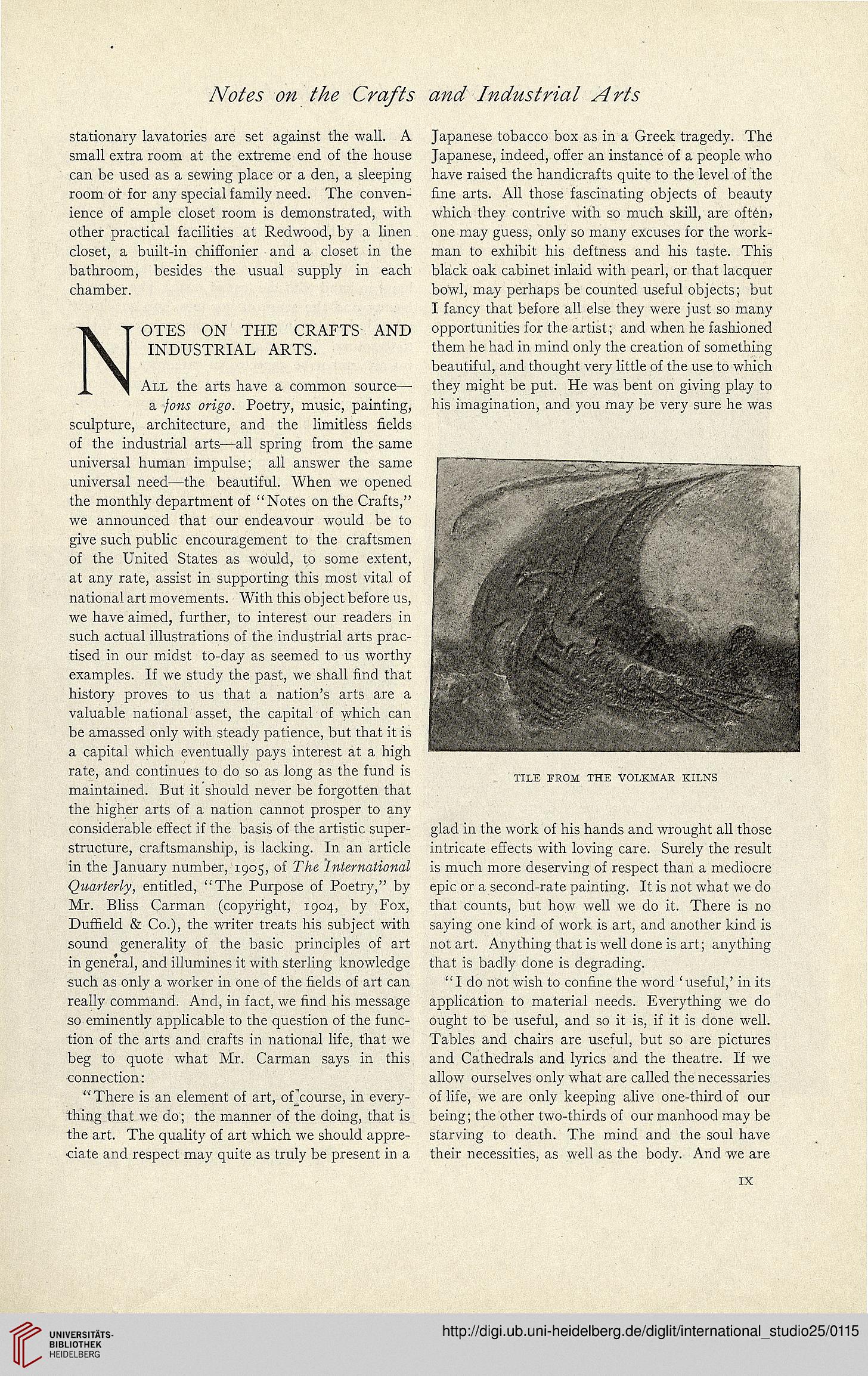stationary lavatories are set against the wall. A
small extra room at the extreme end of the house
can be used as a sewing place or a den, a sleeping
room of for any special family need. The conven-
ience of ample closet room is demonstrated, with
other practical facilities at Redwood, by a linen
closet, a built-in chiffonier and a closet in the
bathroom, besides the usual supply in each
chamber.
OTES ON THE CRAFTS
INDUSTRIAL ARTS.
AND
ALL the arts have a common source—
a oyfgv. Poetry, music, painting,
sculpture, architecture, and the limitless fields
of the industrial arts—all spring from the same
universal human impulse; all answer the same
universal need—the beautiful. When we opened
the monthly department of "Notes on the Crafts,"
we announced that our endeavour would be to
give such public encouragement to the craftsmen
of the United States as would, to some extent,
at any rate, assist in supporting this most vital of
national art movements. With this object before us,
we have aimed, further, to interest our readers in
such actual illustrations of the industrial arts prac-
tised in our midst to-day as seemed to us worthy
examples. If we study the past, we shall find that
history proves to us that a nation's arts are a
valuable national asset, the capital of which can
be amassed only with steady patience, but that it is
a capital which eventually pays interest at a high
rate, and continues to do so as long as the fund is
maintained. But it should never be forgotten that
the higher arts of a nation cannot prosper to any
considerable effect if the basis of the artistic super-
structure, craftsmanship, is lacking. In an article
in the January number, 1905, of
entitled, "The Purpose of Poetry," by
Mr. Bliss Carman (copyright, 1904, by Fox,
Dufheld & Co.), the writer treats his subject with
sound generality of the basic principles of art
in general, and illumines it with sterling knowledge
such as only a worker in one of the fields of art can
really command. And, in fact, we And his message
so eminently applicable to the question of the func-
tion of the arts and crafts in national life, that we
beg to quote what Mr. Carman says in this
connection:
"There is an element of art, of course, in every-
thing that we do; the manner of the doing, that is
the art. The quality of art which we should appre-
ciate and respect may quite as truly be present in a
Japanese tobacco box as in a Greek tragedy. The
Japanese, indeed, oSer an instance of a people who
have raised the handicrafts quite to the level of the
Ane arts. All those fascinating objects of beauty
which they contrive with so much skill, are often;
one may guess, only so many excuses for the work-
man to exhibit his deftness and his taste. This
black oak cabinet inlaid with pearl, or that lacquer
bowl, may perhaps be counted useful objects; but
I fancy that before all else they were just so many
opportunities for the artist; and when he fashioned
them he had in mind only the creation of something
beautiful, and thought very little of the use to which
they might be put. He was bent on giving play to
his imagination, and you may be very sure he was
TILE FROM THE VOLKMAR KILNS
glad in the work of his hands and wrought all those
intricate effects with loving care. Surely the result
is much more deserving of respect than a mediocre
epic or a second-rate painting. It is not what we do
that counts, but how well we do it. There is no
saying one kind of work is art, and another kind is
not art. Anything that is well done is art; anything
that is badly done is degrading.
"I do not wish to conAne the word 'useful,' in its
application to material needs. Everything we do
ought to be useful, and so it is, if it is done well.
Tables and chairs are useful, but so are pictures
and Cathedrals and lyrics and the theatre. If we
allow ourselves only what are called the necessaries
of life, we are only keeping alive one-third of our
being; the other two-thirds of our manhood may be
starving to death. The mind and the soul have
their necessities, as well as the body. And we are
IX





